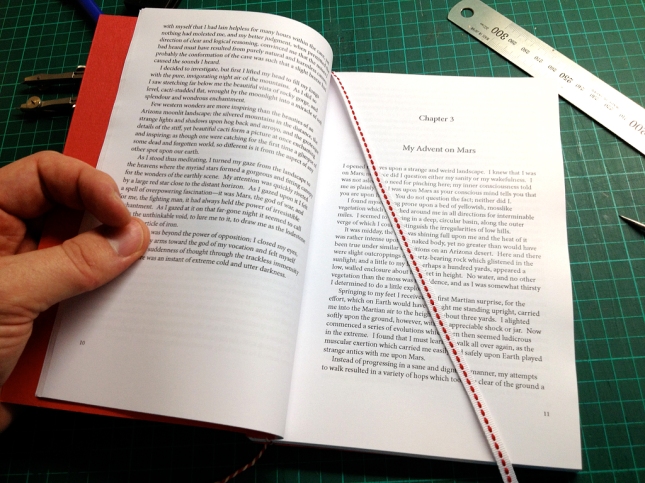A Bit of Inspiration
So I read this post the other day about binding a copy of Edgar Rice Burroughs’ A Princess of Mars, and I thought to myself, “Sounds like an interesting novel, and it looks like that movie John Carter is based on it. I might head over to Project Gutenberg to see if I can download it and bind it”. I got inspired by the trailer I had seen of the movie so I did. And I finished binding it the other night and am just finished reading it. Getting it print-ready was another story though.
I decided to retry TeX (after previously attempting to produce a printable PDF of Pride and Prejudice), and spent an inordinate amount of time prodding and poking among its many vagaries and eventually came up with the PDF document I used to print the text. There are some errors it, such as some American to Australian English spelling left overs, some errors in the TeX markup (typographic quote markup mistakes), and some things which I should have removed, but didn’t. I am working on them, and hope to release an updated PDF in the future. If you want to try TeX for yourself (specifically ConTeXt), you can email me for the TeX file. Unfortunately I cannot upload the file itself as WordPress.com only allows certain file types—among which are Microsoft Office documents, go figure.
After printing the book and realising that I had those few mistakes and that the grain is in the wrong direction, I decided to press on with binding it, but rather than doing a nice case binding, I chose a quick and simple method: the Japanese Stab Stitch book. I drilled the holes after clamping the book tightly between a block of wood and a bit of board with my trusty hand-drill and a 3mm twist bit. It worked rather well, and left some nice and neat holes for me to sew up using some nice cord I bought ages ago.
So I present to you the newest e-reader: the book.
My E-Reader’s Pros
- It won’t run out of battery, and it doesn’t need charging.
- It won’t get stolen, and other people won’t look at it and judge me for not having the latest bit of technology.
- If I drop it, it doesn’t shatter into a googolplex of small pieces.
- It looks and feels like a book, because it’s a real book.
- It can be written and scribbled on with ease.
- It teaches me about patience because I need to wait to get the book ready before I can read it.
And Its Cons
- I can only ever read one book with my book; it can’t become another book with the touch of a button.
- It won’t magically repaginate itself after I turn it on its side.
- It takes ages to get it set up satisfactorily into the format I want it.
- Holding open a book that is stab-stitched (and where the grain is in the wrong direction) for any length of time is tough work on the thumbs.
I am sure there are more, and even more funny slash witty ones.
What Did I Think of the Book?
I really enjoyed the book. I loved the contrast of the almost archaic language and the contemporary themes of science fiction and exploring other planets. I have just read—reread in some cases—a lot of the Sherlock Holmes stories by Sir Arthur Conan Doyle, so I was used to the language. In some parts, I cringed at the now sci-fi slash fantasy language clichés, but when you think that this book is the grand daddy of most modern sci-fi, it is forgivable. I can’t wait to see the movie—it has gotten pretty bad reviews, I’ve heard, but one of my colleagues who has seen it thought it was very good, but said you had to go into it with the understanding that not much will be new, because it is such an old story and has been the inspiration (indirectly) for much of the sci-fi of today.
What’s Next?
Well, I am in the middle of preparing the next book in the Barsoom series, The Gods of Mars, into a printable PDF. I thought I’d go for something a bit different, and print it as A4s 2-up on A3 (so each A3 would contain four pages), and arrange the text into two columns. I am planning on this book to do a case binding, because the stab stitch binding makes the book too hard to keep open. It is an experiment, and I hope that the columns will make the text more readable. I am also planning to set up the page margins according to the Canons of Page Construction, and in particular, this guide, which helps a book designer construct a page so that the margins and text areas are pleasing to the eye.
Why Are My Headings All Questions?
I don’t know, but I’ll keep you posted. Incidentally, I took all the photos for this post with my iPhone 4S—not too shabby, huh?


